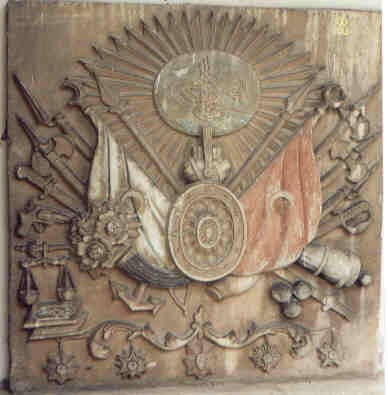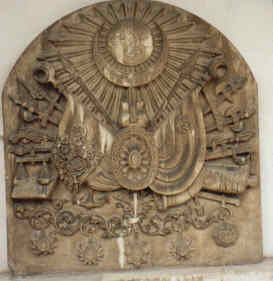 Photography by Dov Gutterman
Photography by Dov GuttermanClick on image to see a larger version

Last modified: 2005-01-22 by ivan sache
Keywords: topkapi | istanbul | quran | sultan | osman | coat of arms: ottoman | selim i |
Links: FOTW homepage |
search |
disclaimer and copyright |
write us |
mirrors
See also:
 Photography by Dov Gutterman
Photography by Dov Gutterman
Click on image to see a larger version
 Photography by Dov Gutterman
Photography by Dov Gutterman
Click on image to see a larger version
The flags shown on the second coat of arms are with a crescent and star whereas those shown on the first one are with a crescent only.
Dov Gutterman, 31 July 1999
The red sandjak of the Ottoman sultan Selim I represents the Zulfikar sword. This flag carried to Egypt by Selim I (1466-1520) can be seen in the Topkapi Museum. During the XVIth and the XVIIth centuries the Zulfikar flags were widespread in Ottoman army and numerous red Zulfikar flags left in the battles in Europe are shown in museums and one can even see a red, triangular Zulfikar flag in the Doge Palace in Venice.
Baris Kilicbay, 20 August 1999
The following items were shown in an exhibition of the masterpieces of the Topkapi Museum (Istanbul), held in the Palace of Versailles (France), Summer 1999.
Quran box for a banner
This is a small (ca. 15 x 5 x 2 cm) silver box which contained a Quran and was tied to the top of the Army banners, to put God's protection of them. This might be put in parallel with the famous oriflamme, which had the same kind of protective power for the ancient kings of France.
Sultan's ceremonial caftans
Some of the displayed caftans are ornated with the three discs placed in triangle which appear also on the flag of the Rear Admiral of the Porte in a XIXth century Dutch flag chart. The notice of the exhibition said that